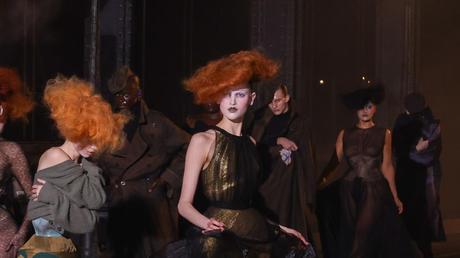
When I saw the first clip of John Galliano's most recent couture show for Margiela, I thought it was an old video from the '90s. A model staggered down a dimly lit street, her arms flailing as if held up by puppet strings. She wore a voluminous white blazer, with a black web of ribbed netting wrapped around her like a web. The whimsical, voluminous silhouettes; the over-the-top drama; the sense of spectacle: it all felt like the kind of show Galliano was famous for in the pre-internet age.
But then I saw another clip of the same scene, with model Leon Dame holding his lapel as he sprinted down the street as a catwalk. And then another of actress Gwendoline Christie with a face painted like a porcelain doll, wearing a sheer, layered latex dress. It turned out that the show had not taken place decades ago, but yesterday in Paris, on the last night of couture week, in the year 2024.
It reminded me of something fashion journalist Dana Thomas said in her book Gods and kings, which chronicled the rise and fall of the two biggest fashion giants of the late 20th century: Alexander McQueen and John Galliano. "With Galliano," she wrote, "you got a sense of the flamboyant possibilities of fashion - beautifully absurd, he intoxicated us with excess. And there was always a fusion and dissonance between the present and the past, as if you were witnessing fashion history through the immediacy of the moment."
I grew up watching Galliano's wild stage shows years later on YouTube, always with a hint of bitterness. They made me feel like I was born in the wrong generation; What I wouldn't give to be there to witness those scenes in real time, with nothing but a notebook on my lap! That dizzying era came to an end in 2011, when Galliano was expelled from Dior after a drunken anti-Semitic outburst. After working for several years at Jewish organizations and undergoing rehab, he quietly took over the reins at Margiela in 2014. His talent has remained undeniable, but perhaps as penance he has stayed out of the spotlight.
The story continues
But that all changed last night. Margiela's couture show immediately went viral, which is almost ironic considering the last sentence from the show notes: Would you like to walk with me offline?
And yet the 30-minute show, which started with a short film by Baz Luhrmann, was extremely online. When I watched it afterwards (still on YouTube, unfortunately, although it felt a little more magical knowing it had happened in a timeline where I was alive and conscious and very much gagged), I immediately noticed all the phones. The models floated down the catwalk with frozen, doll-like facial expressions, surrounded on all sides by glowing screens.
But despite the fact that it's exactly the kind of thing that everyone wants to have images of, to point to in a busy bar in a few months and say I was there! - the show didn't feel squashed by the algorithm. Even on my phone it seemed alive, with fashion so ingrained that I felt present in my own body. Watching it wasn't the same as watching a movie, but I felt like I was devoured by it.
It wasn't just the staging; the clothes themselves were transcendent. That's probably because in the twelve months he spent designing the collection, Galliano managed to introduce a handful of brand new couture dressing techniques. One of these, 'retrograding', uses variations on threadwork, appliqué or encrustation to simulate the degeneration of detail that occurs when an image is recreated. Another, "emotional cutting," is exactly what it sounds like: a way of cutting through fabric that, Galliano says, imbues the garment with the unconscious gestures that shape our expressions. The press release specified that Margiela's signature gestures are haste, the bourgeois gesture and unconscious glamour.
The designer described the show as "a walk through the underbelly of Paris," which might remind some of his controversial collection inspired by the unhouseds of Paris that almost got him fired from Dior in 2000. But this time he gestured to a much-referenced historical era: the late 19th century world of prostitutes and gamblers. The show looked like a breathing Toulouse-Lautrec painting, with narrow-waisted silhouettes, sheer full-skirted dresses and elaborate Edwardian hats reminiscent of the shapes from Galliano's fall 2005 Dior couture show.
To me, it felt like the cast of characters were personalities of the night - people who could only exist in a city like Paris, with unconventional lives, jobs and stories, coming together in a run-down nightclub to relive times that no longer exist and enjoy each other's misunderstood company. Legendary makeup artist Pat McGrath gave the models glassy, porcelain skin, making them look like dolls, hinting that this kind of seedy bohemianism is something we can all play with, but can't always become.
Some models held themselves in their own embrace; others moved their arms like bird wings. And there was also movement in the audience. Instead of the usual stone-cold pursing of the lips, the grin slid across the cheeks and the feet thumped against the floor in excitement. At home I made the same expressions. Fashion hasn't felt like this in a long time. Let's hope this is the start of something new, and not just a quick nostalgic dip into a past that is long gone.
You might also like it